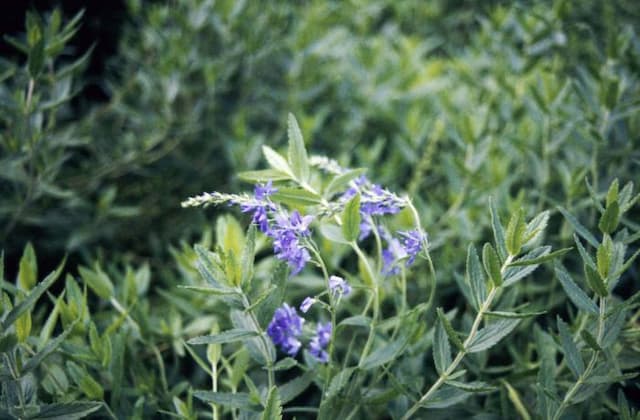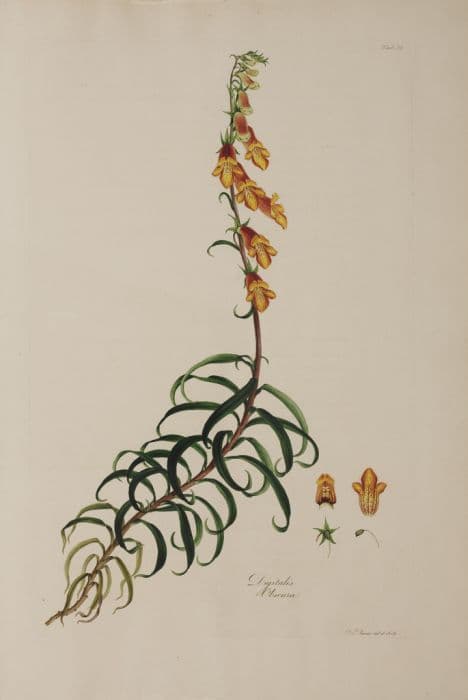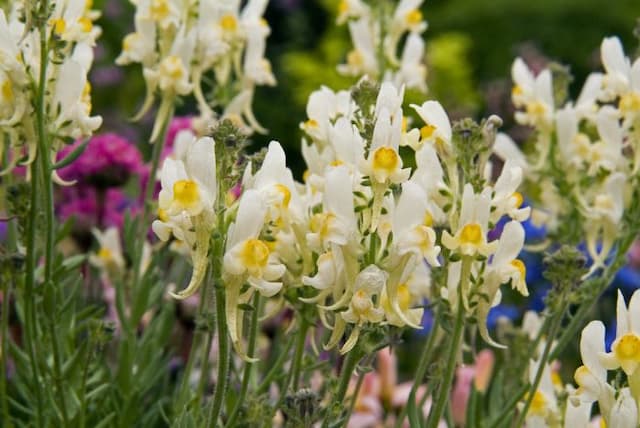Snapdragon Antirrhinum majus 'Bells Yellow' (Bells Series)

ABOUT
Antirrhinum majus 'Bells Yellow' (Bells Series), commonly known as Snapdragon, is a delightful addition to any garden with its vibrant yellow flowers that resemble little bells or the snouts of dragons, hence the playful common name. Each flower is characterized by a two-lipped structure; the upper lip has three lobes while the lower lip has two, creating a perfect landing pad for pollinators. The bloom has a tubular base that flares into a wide-open mouth when viewed from the front, inviting a closer look. Snapdragons produce flowers in dense spikes that rise above the foliage, giving the impression of a towering flame of color when they are in full bloom. The foliage itself consists of deep green leaves that are lance-shaped, lending a textured backdrop to the vivid blossoms. These leaves are arranged in a tight rosette at the base, from where the flowering stalks emerge. The overall appearance of the plant is one of substantive grace and perennial cheer, making it a favorite for gardeners looking to add a splash of sustained yellow to their landscapes. Despite having omitted detailed size measurements, it's clear that the Snapdragon can add significant visual interest to garden spaces without overwhelming them, an ideal plant for creating pockets of bright, sunny color.
About this plant
 Names
NamesFamily
Plantaginaceae.
Synonyms
Snapdragon, Garden Snapdragon, Common Snapdragon, Dog's Mouth, Lion's Mouth, Toad's Mouth.
Common names
Antirrhinum majus 'Bells Yellow' (Bells Series).
 Toxicity
ToxicityTo humans
Snapdragons, including the Antirrhinum majus 'Bells Yellow' from the Bells Series, are generally considered non-toxic to humans. They are not known to cause serious poisoning or present significant health risks when touched or ingested. However, as with many plants, individual reactions can vary, and some people may experience mild discomfort or irritation if they have specific sensitivities or allergies. If significant quantities are ingested, gastric distress such as nausea or upset stomach may occur due to the unusual nature of the plant material in the diet, rather than specific toxic properties.
To pets
Snapdragons, such as the Antirrhinum majus 'Bells Yellow', are widely regarded as non-toxic to pets, including cats and dogs. They are not known to contain any substances that pose a significant risk of poisoning to pets. While it's generally not advisable for pets to consume plant material as it can sometimes lead to gastrointestinal upset or an obstruction, snapdragons are not expected to cause serious health issues if ingested in small amounts. Nevertheless, supervision is advised to prevent pets from ingesting large amounts of any plants, edible or not, to avoid potential digestive discomfort.
 Characteristics
CharacteristicsLife cycle
Annuals
Foliage type
Semi-deciduous
Color of leaves
Green
Flower color
Yellow
Height
1-2 feet (30-60 cm)
Spread
1-2 feet (30-60 cm)
Plant type
Herb
Hardiness zones
9
Native area
Mediterranean
Benefits
 General Benefits
General Benefits- Attracts pollinators: Antirrhinum majus 'Bells Yellow', commonly known as Snapdragon, helps support the local ecosystem by attracting bees, butterflies, and other beneficial insects.
- Vibrant color: The 'Bells Yellow' cultivar offers bright yellow blooms that can be an eye-catching addition to any garden or landscape.
- Seasonal interest: Snapdragons generally bloom from spring to fall, providing extended periods of color and interest in the garden.
- Cut flowers: The blooms of the Snapdragon make excellent cut flowers, allowing you to bring the beauty and color of your garden indoors.
- Easy to grow: Snapdragons are known for being easy to cultivate, requiring minimal care and being adaptable to a variety of soils and conditions.
- Deer resistance: These plants are often resistant to deer, which can help maintain their aesthetic appeal in areas with a high deer population.
- Compact size: The 'Bells Series' Snapdragons are known for their compact growth, making them suitable for borders, containers, and small gardens.
 Medical Properties
Medical Properties- This plant is not used for medical purposes.
 Air-purifying Qualities
Air-purifying QualitiesThis plant is not specifically known for air purifying qualities.
 Other Uses
Other Uses- Art and Craft Material: Snapdragon 'Bells Yellow' petals can be used to create natural dyes for fabrics or inks for paintings, providing a range of yellow hues for artistic projects.
- Photography Subject: The distinct yellow flowers of Snapdragons serve as an excellent subject for macro photographers, enhancing portfolios with their unique aesthetic.
- Educational Tool: Snapdragons can be grown by children in school gardens as part of biology education, teaching them plant life cycles and pollination processes.
- Floral Confetti: Dried petals of the Snapdragon can be used as biodegradable confetti for weddings or celebrations, as a natural and eco-friendly alternative to synthetic confetti.
- Potpourri Ingredient: The colorful flowers of Snapdragons, when dried, add visual appeal and a mild scent to homemade potpourri mixtures.
- Garden Companions: Planting Snapdragons among vegetables can increase garden biodiversity and may help to deter certain pests with its bright flowers.
- Winter Garden Interest: In milder climates, Snapdragon 'Bells Yellow' can provide color in winter gardens when most other plants are dormant.
- Pressed Flower Projects: The flowers of the Snapdragon can be pressed and used for creating bookmarks, greeting cards, or other decorative crafts.
- Seed Harvesting: Seeds from Snapdragons can be collected and used to teach about seed saving and sustainability practices.
- Culinary Garnish: Although not frequently used, the flowers of Snapdragons are edible and can add a pop of color as a garnish on salads or desserts.
Interesting Facts
 Feng Shui
Feng ShuiThe plant_name is not used in Feng Shui practice.
 Zodiac Sign Compitability
Zodiac Sign CompitabilityThe plant_name is not used in astrology practice.
 Plant Symbolism
Plant Symbolism- Deception or Grace: The snapdragon part of the name "Antirrhinum" comes from the Greek words "anti" (like) and "rhin" (nose), referring to the nose-like shape of the flower. This feature has given the flower a sort of playful deception, as they appear as something they are not. However, because of its intricacy and beauty, it also symbolizes grace.
- Strength: The sturdy stem and the vivid colors of the snapdragon also represent strength and resilience in the face of adversity.
- Protection: Since snapdragons are often planted in gardens to guard against rabbits and deer, they have come to symbolize protection.
- Chivalry: The snapdragon's growth habits and strong stems have caused it to be associated with chivalry and honor.
 Water
WaterSnapdragons prefer consistent moisture, so water them deeply when the top inch of soil feels dry to the touch. During hot weather, this may mean watering once or twice a week. It's best to use a watering can or a hose with a diffuser to gently water at the soil level, avoiding wetting the foliage. An average snapdragon plant may require approximately one gallon of water per week, depending on weather conditions and soil type. Adjust the amount and frequency of watering based on rainfall and temperature, making sure the soil is moist but not soggy.
 Light
LightSnapdragons thrive in full sun to partial shade. The ideal location is a spot that receives at least 6 to 8 hours of direct sunlight per day. If you're growing them in a particularly hot climate, providing some afternoon shade can prevent the flowers from wilting. Avoid deep shade as it can lead to leggy growth and reduced blooming.
 Temperature
TemperatureSnapdragons prefer cool to moderate temperatures and can survive in conditions where nighttime temperatures drop down to the low 40s°F and daytime temperatures are in the 70s°F. The ideal growing temperatures for snapdragons are between 60°F and 75°F. They can withstand a light frost, but temperatures below 40°F or above 85°F can adversely affect their growth and flowering.
 Pruning
PruningPruning snapdragons encourages bushier growth and more flowers. Deadhead spent blooms regularly to promote continuous flowering. In mid-season, you can cut back the plants by about one-third to rejuvenate them if they become leggy. Pruning is best done after a flush of blooms fades, and throughout the growing season as needed to keep the plants tidy and flowering.
 Cleaning
CleaningAs needed
 Soil
SoilThe Snapdragon 'Bells Yellow' thrives in a well-draining soil mix with added organic matter like compost or peat moss. The soil should be slightly acidic to neutral, with a pH range of 6.2 to 7.0. A mix of two parts garden soil, one part peat moss or compost, and one part perlite or sand makes an ideal soil environment for this plant.
 Repotting
RepottingSnapdragon 'Bells Yellow' usually does not require frequent repotting as it is often grown as an annual. However, if grown as a perennial, repotting every 2-3 years or when the plant becomes root-bound in the springtime is recommended to replenish nutrients and encourage healthy growth.
 Humidity & Misting
Humidity & MistingSnapdragon 'Bells Yellow' prefers a moderate level of humidity but is quite adaptable to various conditions. It will flourish in humidity levels common to most homes, which typically range from 40-60%. It is tolerant of drier air but benefits from increased humidity in hot, dry climates.
 Suitable locations
Suitable locationsIndoor
Ensure bright light with some direct sun, and keep the soil moist.
Outdoor
Plant in full sun to partial shade and keep soil well-drained.
Hardiness zone
7-10 USDA
 Life cycle
Life cycleAntirrhinum majus 'Bells Yellow', commonly known as Snapdragon 'Bells Yellow’, begins its life cycle as a seed which, with proper conditions of warmth and moisture, germinates into a seedling. The seedling then develops true leaves and grows into a vegetative plant, entering a rapid growth phase where stems, leaves, and root systems expand. As the plant matures, it enters the flowering stage, producing distinctive yellow bell-shaped blooms that attract pollinators. After pollination, the flowers develop into fruit capsules containing seeds. Once the seeds mature, the plant enters a period of senescence where it begins to decline, with foliage browning and drying. The seeds are then dispersed, completing the cycle, and remain dormant until conditions trigger the next generation to germinate.
 Propogation
PropogationPropogation time
Spring to Summer
The most popular method of propagation for the Antirrhinum majus 'Bells Yellow', commonly known as the Snapdragon 'Bells Yellow', is through seed sowing. Sow Snapdragon seeds indoors about 8 to 10 weeks before the last frost date. Use a well-draining seed-starting mix, planting the seeds on the surface since they need light to germinate. Keep the soil uniformly moist and maintain a temperature of about 65 to 70 degrees Fahrenheit (18 to 21 degrees Celsius). Germination typically occurs within 10 to 21 days. Once seedlings have a few true leaves, they can be transplanted to individual pots before eventually moving outdoors after the danger of frost has passed. Seedlings should be acclimated to outdoor conditions gradually to prevent shock.









